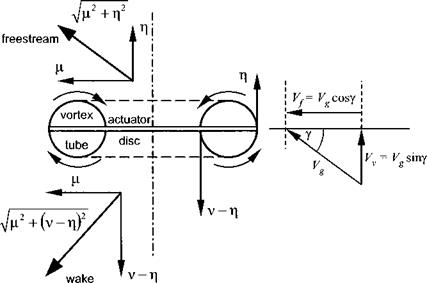Improved predictions
The ‘Wolkovitch’ boundaries although based on a detailed representation of the vortex-ring condition fail to match empirical data. Experience gained from wind tunnel experiments and flight test suggests that the vortex-ring condition can be escaped by allowing a forward velocity component to develop. Thus the lower boundary should show that as the horizontal velocity (q) is increased higher rates of descent (q) are required to enter the vortex-ring state. This can be achieved if the Wolkovitch approach is modified to account for the effect of forward speed on the wake geometry, see Fig. 2.20.
|
|
|||
|
|||
|
|||
|
|||
|
|||
|
|||
|
|||
|
|||
|
|||
|
|||
|
|||
|
|||
|
|||
|
|||
|
|||
|
|||
|
|||
|
|
||
Therefore the lower vortex-ring boundary is given by:
2
ц = v——
![]() VJ
VJ
2 1 4
p = 7 – V6-
The upper vortex boundary is obtained in an analogous manner, by replacing v with kv in Equation (2.23). As mentioned above, Wolkovitch recommended k = 1.4 as denoting the edge of the fully developed vortex ring condition. Peters and Chen [2.22], on the other hand, prefer k= 2 as indicating the condition beyond which no vortex is present anywhere in the streamtube. Hence Equation (2.23) becomes:
31
p2 = 2 ^2v) — ц2 — ^(2v)2 = 3^ — ц2 — 2v2
Once again from momentum theory, 1 = v2(p2 _|_ ц2 — 2^ + v2), thus: 1 = v2(3^ — ц 2 + ц2 — 2v2 — 2цv + v2)
1 = v2^v — v2) = — v4
1
Ц = v + —
v3
Consequently:
Therefore the upper vortex-ring boundary is given by:
1
Ц = v + —
![]() v3
v3
These boundaries are shown in Fig. 2.21. Clearly the lower boundary approximates to the empirical trend whereby with forward speed higher rates of descent are required to enter the vortex-ring state. There are, however, two issues that remain unresolved. First the upper and lower boundaries should predict the same forward velocity, above which vortex-ring can be completely avoided. Secondly the upper boundary is based on entry to the windmill-brake state (Vv = 2vih in the hover) whereas the lower indicates entry into fully developed vortex-ring (V = 0.7vih in the hover). In order to resolve these problems the lower boundary must be further modified to start at p = 0, ц = 0. This is achieved by noting that a vortex will appear in the streamtube when (b-a)/ Ib|< 0. Thus the lower boundary should be given by:
![]() p2 + ц(ц — v)
p2 + ц(ц — v)
V^2 + (v — ц)2
|
Fig. 2.21 Vortex-ring boundaries using modified Wolkovitch analysis. |
Applying momentum theory gives:
1 = v2(^v — Ц + Ц — 2qv + v2)
1 = v2(v2 — цу)
1
Ц = v ——
Consequently:
^2=3v (v—УЗ)—(v—УЗ)— 2у2=У2—У6
Therefore the complete criteria, see Fig. 2.21, for the vortex-ring state are:
1
Ц = v±—
2 1 1
^ = 7 — У6
These criteria can be used to predict a complete and coherent boundary for the onset of the vortex ring condition [2.22].













